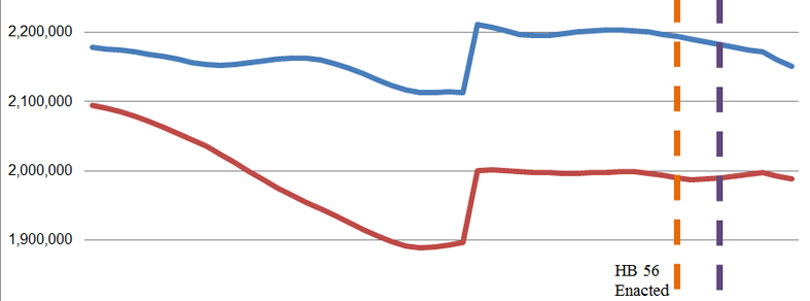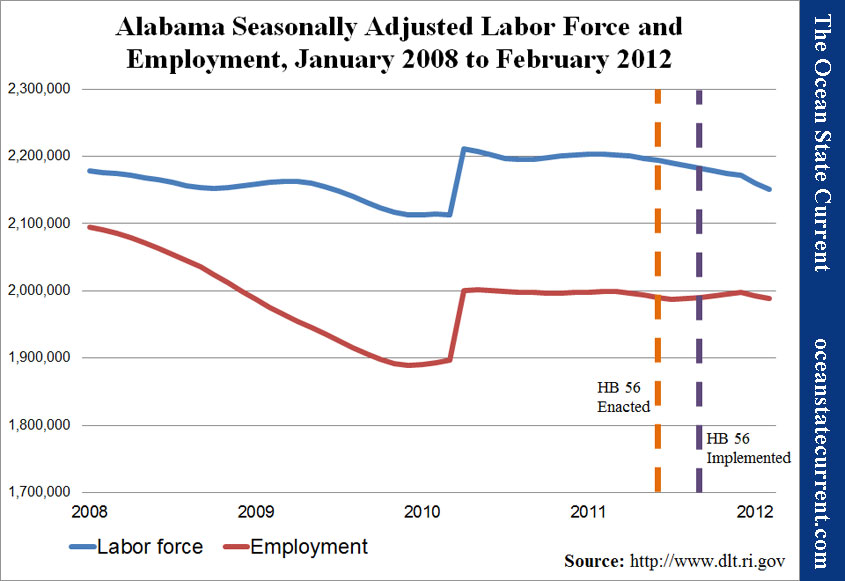Lower Unemployment in Alabama Corresponds with Immigration Law
One really has to wonder how people considered themselves informed back before the Internet enabled almost instantaneous research around the world. (Then again, it can hardly be assumed that opportunity equates with activity.)
In the February 20 edition of National Review’s “The Week” column (subscription required), the editors highlight a link between immigration law and unemployment that is timely for and ought to be of interest to Rhode Islanders:
What accounts for Alabama’s sudden success in reducing unemployment? State officials are crediting Alabama HB 56, the nation’s toughest state law targeting activity by or on behalf of illegal immigrants. In spite of numerous legal challenges, including a full-court press by the Department of Justice, most provisions of the law went into effect at the end of September. Illegal immigrants have been leaving Alabama ever since — self-deporting, you might say — to the benefit of lawfully resident Alabamians.
Naturally, among the first pages returned on a quick Internet search is on Wikipedia, and it muddies the waters:
Supporters credited the immigration law for the decrease. However, Ahmad Ijaz, Director of Economic Forecasting at the University of Alabama, found that the majority of job growth in 2011 was in the automotive sector — an area of the economy where undocumented workers were uncommon. Ijaz attributed a rise in employment to the retail growth during holiday sales.
Well, typically, unemployment rates are offered in seasonally adjusted terms, so holiday retail wouldn’t make much difference, unless the season is especially good or bad. As for the analysis by industry, that’s a bit premature before we take a look at Bureau of Labor Statistics data for Alabama. Doing so, we find the following:
The first thing to note is that the fluctuations in employment and labor force well before HB 56 was enacted serve as a reminder that such data is (a) estimated and (b) subject to a great many pressures. The second note should be that illegal immigrants should not be directly reflected in the numbers, although the fact that they’re survey-based leaves room for some effect. And even so, it’s possible for one or more legal immigrant (counted in the numbers) to be sufficiently tied to an illegal immigrant that the incentives for one might as well be incentives for the other.
So, with disclaimers made, can one reasonably interpret the lines to show an effect of immigration law? Certainly.
Most of the effect on the unemployment rate (which is represented as the space between the lines) derives not from an increase in employment, but from a drop in the labor force. That means either that people who weren’t working left or dropped out of the picture or that people who were working left and people who weren’t filled their jobs.
Alabama’s total labor force began to drop in the four months leading up to the passage of the law, at a rate of 1,534 people per month. Then in the four months between enactment and implementation, that monthly rate increased 34%, to 2,645 people per month. In the next four months, after implementation, the monthly labor market decrease accelerated another 76.7%, to 4,671 per month. Over that period, the number of residents who were employed began to fall, but regained most of their losses by December.
Again, making the case for causation in the presence of correlation would require a much more thorough and close analysis. However, it is within reasonable bounds to speculate that illegal immigrants who were inappropriately counted in unemployment figures and legal residents associated with them began leaving the labor force in February, and after a period of adjustment, legal residents and citizens began filling the emptied jobs.
Even if that speculation were proven accurate, the question of emulating Alabama’s legislation would be a matter both of broader economic analysis and of value judgment. Still, one thing that can be said with confidence is that Alabama’s experience gives no reason to believe that its policies would worsen Rhode Island’s employment picture. In the summer of 2009, the unemployment rates of Alabama and Rhode Island were within a percentage point of each other and well above the national average. By February 2012, Rhode Island had only improved about a half a percentage point, at 11.0%, while Alabama had fallen nearly three percentage points, beating the national rate with 7.6%.





